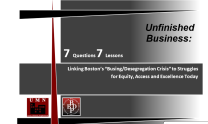Can we stop focusing simply on transactional moves we see as winnable and start working for the transformation of the institutions that perpetuate suffering? –john a. powell
In a side conversation at one of the early report backs on the school assignment process presented by the BPS, I shared my concern with my small group facilitator that in several of the plans there were no “high quality schools” in my “zone” in Roxbury. With a smile he replied that in a few years, the whole complexion of my neighborhood would change including the quality of the schools. Other opinions he shared in our brief conversation let me know that while he was referring to the complexion in terms of race we were also talking about complexion in terms of class. It also let me know that he thought this was a good thing.
Needless to say, it gave me pause and clearly revealed that he and I had very different assumptions and hopes for the future of the city. It was only at a recent presentation by Dr. James Jennings entitled Neighborhood Schools and Neighborhood Inequality in Boston, Massachusetts: Key Questions and Issues for Community Organizing* that the concerns that brief exchange raised for me got focused and reflected on in current conversations about equity, access and excellence “then and now”.
The report lifts up three indicators that have been shown to impact academic excellence and maps where Boston has tremendous inequities:
- Income / Poverty
- Health disparities / food insecurity
- Housing instability
It maps tremendous inequities in Boston around these indicators and raises excellent questions and concerns about the barriers to equitable neighborhoods school when such neighborhood inequities exist.
It offers four strategies for addressing these inequities. Most relevant to the mission of BBDP, it suggests adopting, supporting, and mobilizing around “a theory of change for improving low performing public schools and the raising of the academic achievement of children and youth which acknowledges inequality, and the history of racial inequality”.
IN BBDP’s work, it is sometimes said among those who felt wounded by the busing/desegregation crisis that “it destroyed our neighborhood”. Some version of this came from people of all races, in all communities. On the other hand, many pointed out that great gains were made as desegregation itself gave access to jobs and other resources to many who had previously been excluded by race or class. Both are true and largely influenced by where we each stand in the race and class divide.
For very complex reasons, our city and nation have for some years been on a march toward an ever widening wealth and power gap and towards greater segregation and less democracy. What movements in the other direction have taught us is that unless there are specific interventions toward democracy and inclusion that trend continues. These other interventions cannot just include acting against something, they have to be grounded in acting for something.
As we think about current reform efforts, the question of what kind of city do we want and for whom must be prominent in our exploration. This report by Dr. Jennings helps us widen the conversation.
My facilitator’s off-the-record comments were his personal opinions. There are many –perhaps a majority– in BPS, in city government, in schools, in neighborhoods who want something different—who are committed and working to address neighborhood inequality at the root. Even within each of us there are often competing directions on the democratizing/anti-democracy tension. We have to struggle with ourselves and each other—such struggle is at the heart of democratic process.
Dr. Jenning’s report raises many of the issues we must address and the questions we must face if we are going to support a school system and a city that works for all of us. That gives all our children—including people of color and impoverished children—a chance and the resources to reach their highest potential. This is the time to come together to find democratic processes to take the school system and our other institutions in the other democratizing direction. The answers are out there. We have a historical as well as innovative new ideas to draw on to educate all our children if we solidify what public will we have to do so.
* the full report has not been completed but click here to see a presentation on it.

